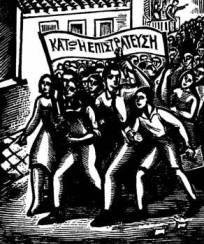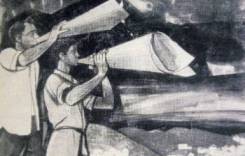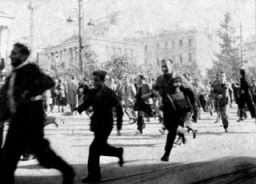 |
| Σπάνιο φύλλο της εφημερίδας "Η ΜΑΧΗ", έκδοση της οργάνωσης "ΕΘΝΙΚΗ ΔΡΑΣΙΣ", η οποία αναφέρεται στα γεγονότα της 5ης Μαρτίου του 1943 (Αρχείο pierrekosmidis.blogspot.com) |
Αρχές του 1943 η πανωλεθρία των ναζί στη μάχη του Στάλινγκραντ έγειρε οριστικά την πλάστιγγα του πολέμου στην πλευρά των συμμάχων.
Οι τεράστιες απώλειες τους (πάνω από 850.000 νεκροί, αιχμάλωτοι και τραυματίες) καθιστούν άλυτο το ήδη οξυμένο πρόβλημα των εφεδρειών τους.
Προκειμένου να το αντιμετωπίσουν, αναγκάζονται στην επιστράτευση βιομηχανικών εργατών, οι οποίοι στέλνονται στο μέτωπο.
Έτσι το πρόβλημα μετατοπίζεται στην αναπλήρωση των κενών στη πολεμική τους βιομηχανία.
Καθώς το πρόγραμμα «εθελοντικής» εργασίας από τις κατεχόμενες χώρες έχει αποτύχει, στρέφονται στη λύση της πολιτικής επιστράτευσης στις χώρες αυτές.
Στις 19 Φεβρουάρίου ο Γκέμπελς δήλωνει: «Ο γερμανικός λαός δίνει το αίμα του, η υπόλοιπη Ευρώπη ας δώσει την εργασία της».
Οι φήμες περί επικείμενης επιστράτευσης στην Ελλάδα φουντώνουν.
Ο κατοχικός "Κουίσλινγκ" πρωθυπουργός Λογοθετόπουλος προκειμένου να διασκεδάσει τις φήμες δηλώνει:
«Η ελληνική κυβέρνησις διαψεύδει κατηγορηματικώς τας κυκλοφορούσας φήμας σχετικώς με δήθεν μελετόμενην πολιτικήν επιστράτευσιν.» Η διάψευση της διάψευσης δεν αργεί να έρθει. Στις 23 Φεβρουαρίου δημοσιεύεται η ακόλουθη διαταγή:
Επί τη βάσει της υπό του Φύρερ και Ανωτάτου Αρχηγού των Ενόπλων Δυνάμεων χορηγηθείσης μοι εξουσιοδοτήσεως διατάσσω τα κάτωθι:
Αρθρον 1ον. Εκαστος κάτοικος της Ελλάδος, ηλικίας από 16 μέχρι 45 ετών είναι υποχρεωμένος, εάν το απαιτήσουν αι περιστάσεις, ν’ αναλάβη υποδεικνυομένην εις αυτόν εργασίαν διά γερμανικάς ή ιταλικάς υπηρεσίας.
Ιδίως είναι υποχρεωμένος να παρουσιάζεται με ακρίβειαν εις την εργασίαν, να τηρή τας ώρας εργασίας και να παρέχη απόδοσιν εργασίας, ανταποκρινομένην προς τας σωματικάς του δυνάμεις.
Οι άνδρες είναι υποχρεωμένοι να εργάζονται έξω του τόπου της μονίμου κατοικίας των συγκεκροτημένοι εις συμβιωτικάς ομάδας στρατοπέδου, εάν απαιτηθή το τοιούτον.
Αρθρον 2ον. Η πρόσκλησις προς ανάληψιν εργασίας γίνεται υπό των γερμανικών αρχών απ’ ευθείας ή υπό των εντεταλμένων προς τούτο ελληνικών αρχών, ιδίως, Επιθεωρήσεων εργασίας, δημάρχων.
Αρθρον 3ον. Αι γερμανικαί υπηρεσίαι παρέχουν ανάλογον προς τας συνθήκας αποζημίωσιν και, εφ’ όσον τούτο είναι δυνατόν, και τροφήν.
Αρθρον 4ον. Ο μη συμμορφούμενος προς τας εκ των άρθρων 1 και 2 απορρέουσας υποχρεώσεις, τιμωρείται με:
1) χρηματικήν ποινήν απεριορίστως ή
2) φυλάκισιν ή ειρκτήν ή
3) στρατόπεδον καταναγκαστικών έργων.
Αρθρον 5ον. Η παρούσα διάταξις τίθεται εν ισχύι από της ημέρας της κοινοποιήσεως αυτής.
Δια του Διοικητού της Νοτιανατολικής Ευρώπης εντεταλμένου ταυτοχρόνως με την αρχηγίαν του στρατού Στρατηγού Σπάϊντελ ».
Την επόμενη μέρα κιόλας, ξεσπούν απεργίες και διαδηλώσεις.
Σύμφωνα με μαρτυρίες των Τάσου Βουρνά και Σόλωνα Γρηγοριάδη, μια μεγάλη ομάδα διαδηλωτών εισβάλει στα Παλιά Ανάκτορα, φτάνοντας στα κυβερνητικά γραφεία.
Η κυριότερη μάζα των διαδηλωτών κατευθύνεται στο Υπουργείο Εργασίας, εισβάλει στα γραφεία και καίει μέρος των αρχείων του στην προσπάθεια να σαμποταριστεί το έργο της επιστράτευσης.
Αστυνομία και καραμπινιέροι ανοίγουν πυρ με αποτέλεσμα 3 νεκρούς και δεκάδες τραυματίες.
Ιταλική έκθεση της ίδιας μέρας αναφέρει: «Η κατάσταση στην Ελλάδα συνεχώς χειροτερεύει…
Έντονη προπαγάνδα συνεχίζει να γεμίζει τους τοίχους ενάντια στην πολιτική επιστράτευση, ενάντια στις συλλήψεις ομήρων που κάνουν οι αρχές κατοχής, ενάντια στον Άξονα γενικά, και ενάντια στην ίδια την ελληνική κυβέρνηση που κατηγορείται για υπερβολική ευπείθεια στον κατακτητή και θεωρείται η κύρια υπεύθυνη για την καταστροφική κατάσταση υποσιτισμού στη χώρα.»
Οι απεργίες και αντιδράσεις συνεχίστηκαν και τις επόμενες μέρες. Στις 25 του μήνα ξεκινά απεργία των υπαλλήλων τις Τηλεφωνικής Εταιρίας ενώ μαθητές και φοιτητές καταβαίνουν σε διαδηλώσεις.
Λειτουργίες σε εκκλησίες διακόπτονται και μετατρέπονται σε διαμαρτυρίες εναντίον της επιστράτευσης. Νεότερη ιταλική έκθεση αναφέρει:
«Αυτές οι διαδηλώσεις, όσο κι αν αποδίδονται στην ανάγκη οικονομικών βελτιώσεων για τους δημόσιους υπάλληλους και τους εργάτες, εχουν αφήσει σαφώς να φανεί η αντι-αξονική τους βάση.»
Προκηρύσσεται Γενική Απεργία Δημοσίων Υπαλλήλων για τις 5 του Μάρτη και το ΕΑΜ οργανώνει διαδήλωση ενάντια στην επιστράτευση για τη μέρα εκείνη.
Η διαδήλωση προπαγανδίζεται πυρετωδώς, με συνθήματα στους τοίχους, πολυγραφημένες προκηρύξεις και τρικάκια.
Σύμφωνα με μαρτυρία του Ν. Πλουμπίδη τα χωνιά της νεοσύστατης ΕΠΟΝ τότε εφευρέθηκαν και τέθηκαν σε εφαρμογή.
Τα γεγονότα της 5ης Μαρτίου αφηγείται ο Δημήτρης Ψαθάς στο βιβλίο του “ΑΝΤΙΣΤΑΣΗ”:
Και φτάνει η μέρα. Ξεσπάει η απεργία Τράπεζες, δημόσια γραφεία, ταχυδρομεία, τηλεγραφεία, μαγαζιά -όλα κλειστά. Τρίζει τα δόντια η ψευτοκυβέρνηση. Οι απεργοί θα παταχθούν! Κι όταν ο Γκοτζαμάνης στρώνεται να γράψει το διάταγμα της απόλυσης των απεργών, δεν βρίσκει μια δακτυλογράφο να το δακτυλογραφήσει!
Τα εργοστάσια σταματημένα.
Κι όλες οι επιχειρήσεις. Η κίνηση της πόλης έχει νεκρωθεί. Πλημμυρίζει η πόλη με παράνομο Τύπο. Μπρος λαέ της Αθήνας!
Μπρος αδούλωτη Ελλάδα! Μπρος για τη μάχη των μαχών! Κι ας περιμένουν στους δρόμος έτοιμα τα ντουφέκια.
Τα μάθαμε αυτά. Άλλο από το να σκοτώνουν δεν μπορούν.(…) Στην οδό Πραξιτέλους γίνεται κακό. Οι Ιταλοί σκορπίζουνε το πλήθος.
Σηκώνουν τα όπλα, βαράνε κοντακιές, ρίχνουν. Μια κοπέλα ορθώνεται μπροστά τους: -Πίσω, παλιόσκυλα!Ένας Ιταλός τη σημαδεύει.
Βροντά το όπλο, σωριάζεται η κοπέλα. Φεύγουν άλλοι, χυμάνε να πάρουν το κορμί. Σε λίγο ο κόσμος που περνά βλέπει στον τόπο που έπεσε η κοπέλα και δακρύζει.
Γύρω – τριγύρω στα αίματα έχουν βάλει πέτρες. Τάφος συμβολικός. Όλη μέρα περνάει πλήθος και ρίχνει λουλούδια. Γλυκοχαράζει η άνοιξη στη γη της Αττικής.
Κι εκεί, στην οδό Πραξιτέλους, πάνω στην άσφαλτο που βάφηκε με το αίμα ενός κοριτσιού, στέλνει τριαντάφυλλα, γαρούφαλα και πασχαλιές. Ένας σωρός από λουλούδια.
Αλλού μάχες σωστές. Κοντά εκατό χιλιάδες τραβούν προς το πολιτικό γραφείο. Φωτιά σκορπίζουν οι Γερμανοί κι οι Ιταλοί. Μηχανοκίνητα βογγούν.
Χειροβομβίδες σκάνε. Πέφτουν οι λαβωμένοι, οι νεκροί. Τους αρπάζουν οι διαδηλωτές και φεύγουν μην πέσουν στα χέρια του κατακτητή. Πρόθυμα ανοίγουν τις πόρτες τους τα σπίτια για να δεχτούν τα θύματα. Γιατροί, νοσοκόμοι, τραυματιοφορείς βοηθάνε.
Κι ο κόσμος που βρίσκεται μπροστά στις μπούκες των όπλων σκορπίζει, αλλά δεν εννοεί να διαλυθεί: -Στου υπουργείο Εργασίας! Άλλο κακό εκεί.
Στις 11.30΄ είναι μαζεμένοι κοντά πενήντα χιλιάδες διαδηλωτές γύρω – τριγύρω χωμένοι στις παρόδους. Τραγουδάνε τον Εθνικό Ύμνο και χυμάνε με πέτρες και με ξύλα. Σπάζουν τις πόρτες και τα παράθυρα.
Κατακίτρινος ο υπουργός Καλύβας ακούει την οχλοβοή ανάμεσα στους καραμπινιέρους που τον φρουρούνε.
Φτάνει ενίσχυση της δύναμης. Αστυνομία ελληνική, Ιταλιάνοι, Γκεστάπο. -Πίσω! Διαλυθείτε!- Μπρος, παιδιά! Απάνω τους!-Θα σας σκοτώσουμε! Σκοτώστε μας! Αρχίζει το πολυβόλο.
Σκάει η χειροβομβίδα. Και τότε γίνεται τούτο τ’ απίστευτο.
Γυναίκες, άντρες και παιδιά ορμούν με πέτρες και με ξύλα πάνω στην ένοπλη δύναμη που ρίχνει. Λαβώνονται πολλοί. Κι άλλοι κουβαλάνε πέτρες στα μαντίλια, άλλοι ξεριζώνουν τις πλάκες απ’ τα πεζοδρόμια.
Μάχη πρωτάκουστη. Τους κυνηγάνε εδώ, φυτρώνουν από κει. Κι ένα πράμα μονάχα δεν έχουν στο μυαλό τους – να διαλυθούν. Τρελοί;Τρελοί!
Εδώ ένας σωριάστηκε τραυματισμένος. Εκεί άλλος κείτεται νεκρός. Εδώ μια ομάδα κοριτσιών που ρίχνουνε πέτρες. Αλλού άλλη ομάδα που κυνηγιέται για να κρυφτεί στους γύρω δρόμους.
Εδώ με ξύλα δέρνονται διαδηλωτές και αστυφύλακες. Εκεί δουλεύει πιστολίδι. Χτυπάν τις πόρτες. Ανοίξτε, τραυματίες! Κι οι πόρτες ανοίγουν όλες. Γεμίζουν οι δρόμοι με χαρτάκια: Κάτω η πολιτική επιστράτευση.
Αρπάζει η Γκεστάπο πολλούς απ’ τους διαδηλωτές: Μαζέψτε τα! Τα μαζεύουν και, καθώς τους πάνε στην Κομαντατούρ ή στο Κομάντο Πιάτσα, τα ξανασκορπάνε.
Το μυρίζονται οι Γερμανοί.
Ξύλο.
Ώρες κρατάνε οι διαδηλώσεις. Ώρες αντηχεί η αντάρα κι ο αλαλαγμός της πόλης.
Οι συγκρούσεις είχαν ως αποτέλεσμα τουλάχιστον 7 νεκρούς και εκατοντάδες τραυματίες.
Tην επόμενη μέρα ο Λογοθετόπουλος δήλωνε:
«Η κομμουνιστική οργάνωσις ΕΑΜ, παρασύρασα δυστυχώς και πολλούς δημοσίους υπαλλήλους και φοιτητάς, μη εισακούσαντας τας θερμάς μου συστάσεις, προκάλεσεν αναρχικάς συγκεντρώσεις ανά την πόλιν με σκοπόν να παρακωλύση την ελευθέραν κίνησιν και λειτουργίαν των δημοσίων καταστημάτων και του εμπορίου.
Το αποτέλεσμα της άφρονος αυτής ενεργείας υπήρξεν η σύγκρουσις των τρομοκρατικών ομάδων με τα όργανα της τάξεως, τα οποία εκτελούντα τας δοθείσας αυστηράς εντολάς της κυβερνήσεως επανέφερον την τάξιν.
Υπάρχουν, δυστυχώς, θύματα και πολλοί τραυματίαι. Διεπιστώθη ότι οι προκαλέσαντες τας χθεσινάς ταραχάς λεηλάτησαν καταστήματα, εισέδυσαν μέχρι και ιδιωτικών κατοικιών, τρομοκρατήσαντες τους ενοίκους με σκοπόν την λεηλασίαν και επυροβόλησαν τους αντιστάντας εις την οργιαστικήν ταύτην επιδρομήν των βανδάλων.
Αι αναρχικαί αυταί συγκεντρώσεις και οι βανδαλισμοί οργανώθησαν με την πρόφασιν διαμαρτυρίας εναντίον της πολιτικής επιστρατεύσεως.
Εδήλωσα ήδη επισήμως προς τον ελληνικόν λαόν οτι η επιστράτευσις δεν πρόκειται να γίνει και οι οποιοιδήποτε εργαζόμενοι εις την υπηρεσίαν των στρατιωτικών αρχών κατοχής δεν θα αποσταλούν προς εργασίαν έξω της Ελλάδος»
Τα σχέδια για πολιτική επιστράτευση ακυρώνονται.
Λίγες μέρες μετά ο Λογoθετόπουλος αντικαθίσταται από τον Ιωάννη Ράλλη.
Βιβλιογραφία
Μark Mazower «Στην Ελλάδα του Χίτλερ»
Τάσος Βουρνας «Ιστορία της νεότερης και σύγχρονής Ελλάδας»
Σόλων Γρηγοριάδης «Ιστορία της σύγχρονής Ελλάδας»
«Ιστορία της Αντίστασης», εκδόσεις Αυλός
Δημήτρης Ψαθάς «Αντίσταση»










































